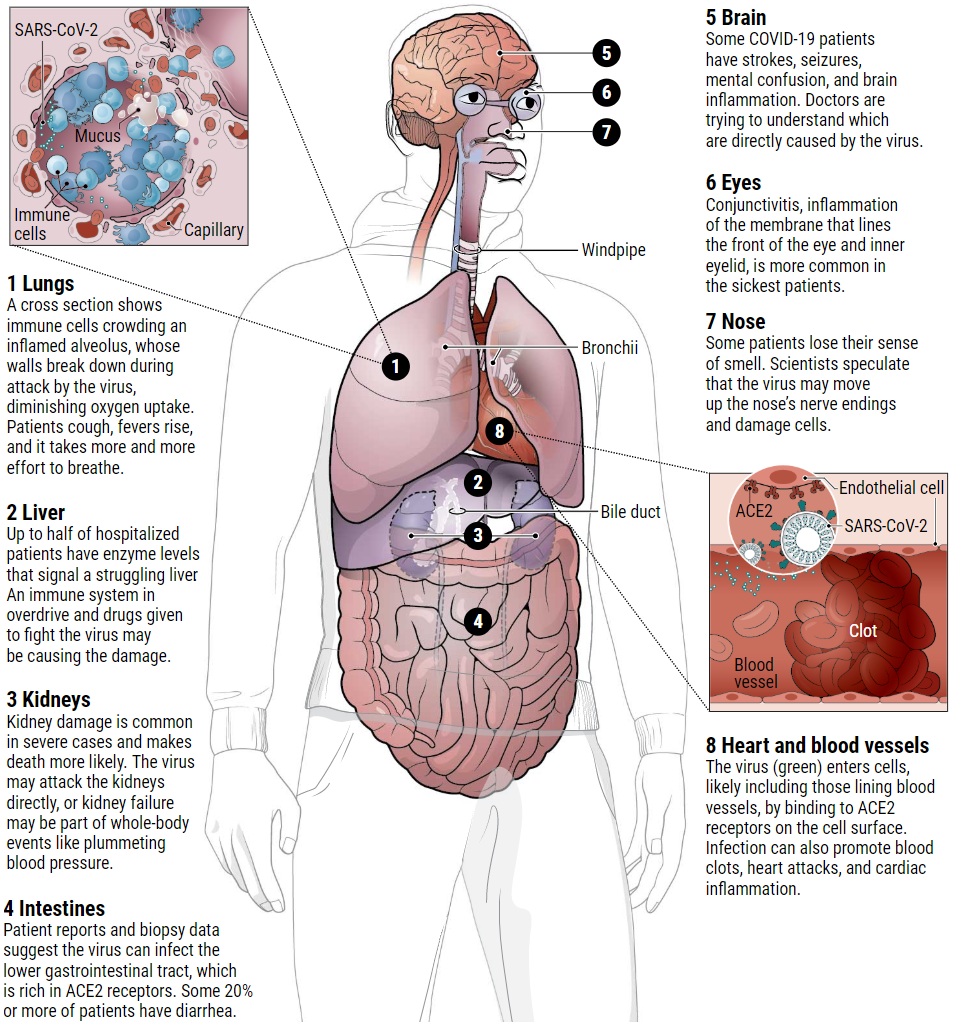每日外闻78
How does coronavirus kill? -5
Striking the heart -2
肺部血管的收缩可能有助于解释由covid19引起的肺炎中出现的一种令人困惑的现象:一些患者的血氧水平极低,但并没有喘不过气来的症状。在疾病的某些阶段,这种病毒可能会改变帮助调节血压的激素的微妙平衡,并收缩通向肺部的血管。因此,收缩的血管而不是阻塞的肺泡阻止了氧气的吸收。Levitt说:“有一种理论认为病毒会影响血管,这就是为什么我们看到氧气水平如此之低的原因”。
如果COVID-19靶向作用于血管,这也可以帮助解释为什么那些先前就有血管损伤的患者,例如糖尿病和高血压患者,会有更高的严重疾病风险。美国疾病控制与预防中心(CDC)最近对美国14个州住院病人的数据分析发现,约有三分之一的人患有慢性肺病,患有糖尿病的人也大概有这么多,而足足有一半的人曾患有高血压。
Mangalmurti说,她对宾夕法尼亚大学医院(HUP)ICU里没有大量哮喘患者或其他呼吸道疾病患者感到吃惊。“让我们非常震惊的是,风险因素似乎是血管:糖尿病、肥胖、年龄、高血压(这些因素都会改变血管的状态)。”
科学家们正在努力研究到底是什么导致了心血管损伤。这种病毒可能会直接攻击心脏和血管的内膜,这些内膜像鼻子和肺泡一样富含ACE2受体。或者可能是由于肺部混乱造成的缺氧损害了血管。或者细胞因子风暴会像破坏其他器官一样破坏心脏。
“我们还在起步阶段,”克鲁姆霍尔兹说。“我们真的不知道谁会对病毒感染比较脆弱,为什么有些人受到如此严重的影响,为什么疫情来得如此迅速……为什么(有些人)很难康复。”
Striking the heart -2
In the lungs, blood vessel constriction might help explain anecdotal reports of a perplexing phenomenon seen in pneumonia caused by COVID-19: Some patients have extremely low blood-oxygen levels and yet are not gasping for breath. It’s possible that at some stages of disease, the virus alters the delicate balance of hormones that help regulate blood pressure and constricts blood vessels going to the lungs. So oxygen uptake is impeded by constricted blood vessels, rather than by clogged alveoli. “One theory is that the virus affects the vascular biology and that’s why we see these really low oxygen levels,” Levitt says.
If COVID-19 targets blood vessels, that could also help explain why patients with pre-existing damage to those vessels, for example from diabetes and high blood pressure, face higher risk of serious disease. Recent Centers for Disease Control and Prevention (CDC) data on hospitalized patients in 14 U.S. states found that about one-third had chronic lung disease—but nearly as many had diabetes, and fully half had pre-existing high blood pressure.
Mangalmurti says she has been “shocked by the fact that we don’t have a huge number of asthmatics” or patients with other respiratory diseases in HUP’s ICU. “It’s very striking to us that risk factors seem to be vascular: diabetes, obesity, age, hypertension.”
Scientists are struggling to understand exactly what causes the cardiovascular damage. The virus may directly attack the lining of the heart and blood vessels, which, like the nose and alveoli, are rich in ACE2 receptors. Or perhaps lack of oxygen, due to the chaos in the lungs, damages blood vessels. Or a cytokine storm could ravage the heart as it does other organs.
“We’re still at the beginning,” Krumholz says. “We really don’t understand who is vulnerable, why some people are affected so severely, why it comes on so rapidly … and why it is so hard [for some] to recover.”
See you tomorrow



